Photosystem II (PSII)
Drilling Down
In the cells of plants and algae are structures called chloroplasts (Fig. 1).
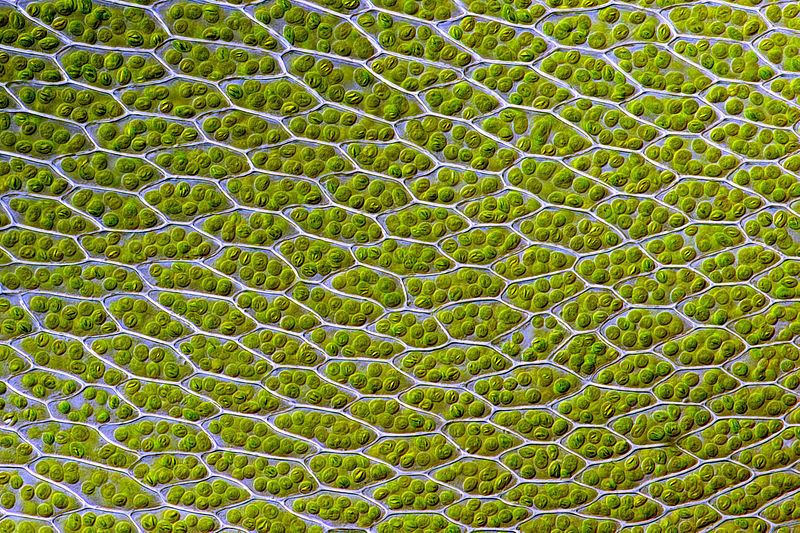
Attribution: Des_Callaghan, CC BY-SA 4.0 , via Wikimedia Commons
(And there is much evidence that these chloroplasts were once independently-living cyanobacteria.)
Chloroplasts have an inner and outer membrane (just like cyanobacteria). Held within the inner membrane is an aqueous liquid called the stroma. Suspended in the stroma are structures called thylakoids, shown as green disk-shaped objects in Fig. 2. These disks are arranged in stacks called grana (plural form of granum).

Attribution: Public Domain, https://en.wikipedia.org/w/index.php?curid=10483833
The dark-green border around each disk in Fig. 2 is the thylakoid’s own membrane, distinct from the chloroplast’s membrane. This membrane keeps the internal part of the thylakoid, called the lumen, together.
Embedded, and spanning, that membrane are four major protein complexes: photosystem II (PSII), cytochrome b6f complex, photosystem I (PSI), and ATP synthase (Fig. 3).
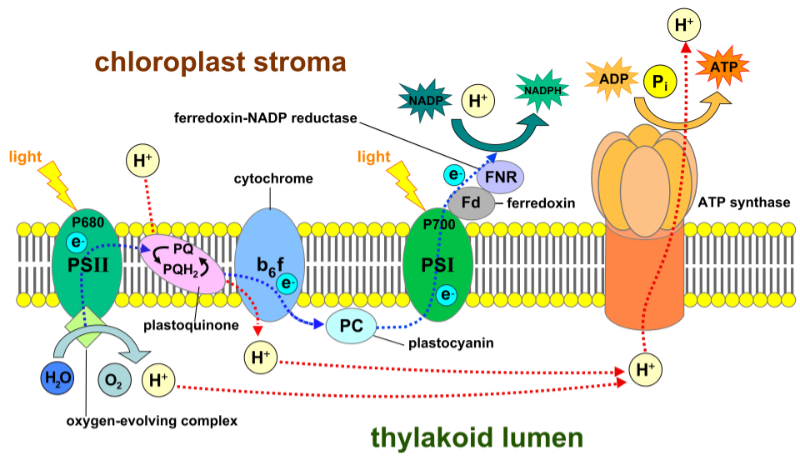
Attribution: By Somepics - Own work, CC BY-SA 4.0, https://commons.wikimedia.org/w/index.php?curid=38088695
They are called protein complexes as each is a unit of several protein subunits.
Photosynthesis begins with Photosystem II (PSII) in the thylakoid membrane. This is the region where photons are absorbed and where water is split, both actions triggering a cascade of reactions that produces oxygen, energy, and sugar.
Without PSII there can be no photosynthesis — at least in plants, algae and cyanobacteria — and some herbicides such as atrazine work by inhibiting PSII.
Photosystem II (PSII)
Photosystem II is an incredibly complicated structure — Fig. 4 is of the PSII of the cyanobacterium Thermosynechococcus elongatus, and it is a simplified representation at that! The above-mentioned protein subunits this PSII protein complex contains are represented here as simple colour-coded rods, but are themselves highly complicated structures as well. Far more detail is here should you be curious!
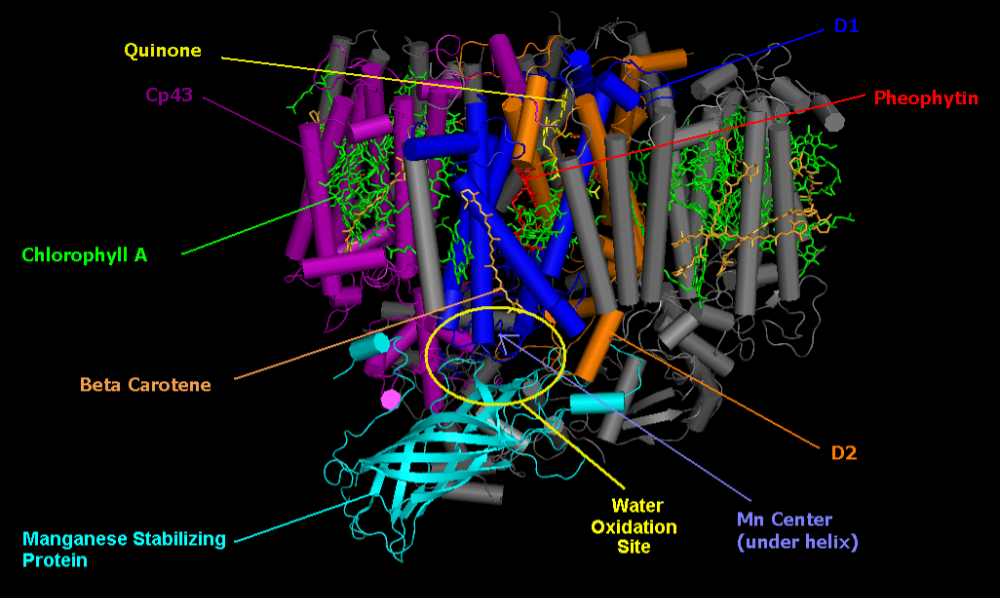
Attribution: Neveu,Curtis (C31004), CC BY-SA 3.0, via Wikimedia Commons
Fig. 5 is a more stylised illustration of PSII:
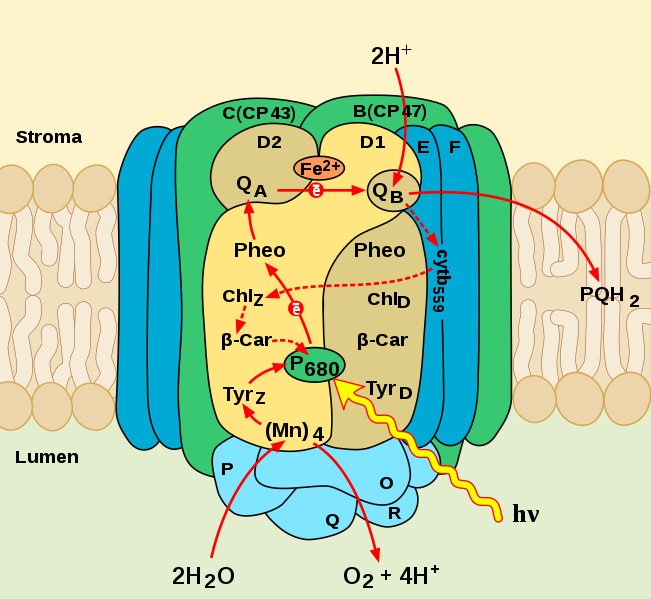
Attribution: Kaidor, CC BY-SA 4.0 , via Wikimedia Commons
As we pick PSII apart, please do keep in mind that PSII is just one of the four protein complexes in the thylakoid membrane involved in photosynthesis — each of the other three have their own, distinct, roles which will be covered elsewhere.
Breaking It Down
Photosystem II is comprised of three main complexes: a light-harvesting complex, a reaction centre core, and an oxygen-evolving complex.
The Light-Harvesting Complex (LHC)
The light-harvesting complex (LHC), also called the antenna complex, contains the photosynthetic pigments. These are the core photosynthetic pigment chlorophyll a and the additional antennae pigments chlorophyll b, the xanthophylls, and the carotenes. Each has a different peak absorption, and combined they increase the absorbable range of light wavelengths. The xanthophylls and carotenes (collectively called the carotenoids) have additional roles as antioxidants — as they do for us when we ingest them — though in PSII they specifically protect the chlorophylls from photon-induced oxidative stress.
Each LHC contains 250 – 400 of these pigment molecules, and the photon energy they absorb is channelled into the reaction centre of PSII. The CP43 and CP47 proteins at top of Fig. 5 are essential in passing this energy on. These are called the light-harvesting proteins.
The Reaction Centre
The reaction centre is made up of two specialised chlorophyll-protein complexes called D1 and D2. Each contains one chlorophyll a molecule, and this molecule pair is referred to simply as P680. (’P’ for ‘pigment’, and 680 for its maximum absorption at 680 nm.)
P680 both absorbs the photon energy channelled from the light-harvesting complex as well as from photons directly.
P680 is the Photosytem II primary donor, as the photon energy it receives excites an electron into such a high energy state that it becomes unstable. This electron readily moves from (is donated by) P680 to another molecule called pheophytin (Fig. 4, and the ‘Pheo’ in Fig. 5). Pheophytin is the primary electron acceptor in PSII — it is reduced (becoming negatively-charged) and P680 is oxidised to P680+.
(Reduction-oxidation reactions are explained in more detail here.)
Via pheophytin, this electron then transfers to another electron acceptor, plastoquinone QA, then onto plastoquinone QB. This electron flow initiated by P680 continues outside PSII and we’ll follow that in other chapters.
P680+, in losing an electron, becomes the strongest biological oxidising agent known, meaning it very readily uptakes electrons from other substances. This is very important when it comes to the third complex of PSII, the oxygen-evolving complex.
The Oxygen-Evolving Complex (OEC)
Also called the water-splitting complex, this process is found only in chloroplasts and cyanobacteria, and is the sole reason Earth’s atmosphere is 21% oxygen today instead of the original not much, if any, of early Earth.
It is here where water (H2O) is split into oxygen and hydrogen.
How the OEC works is not fully understood, but Bessel Kok’s theory from 1970 is the most accepted and is summarised in Fig. 6 below. Chl a is the chlorophyll a known as P680, TyrZ is a tyrosine residue*, and S0 – 4 represents the five states the OEC can exist in, with S0 the most reduced and S4 the most oxidised. Mn is manganese. Calcium and chloride ions (not shown) are also involved.
(* Tyrosine is an amino acid. All amino acids have an identical structure plus one part unique to each amino acid. That unique part is the residue.)
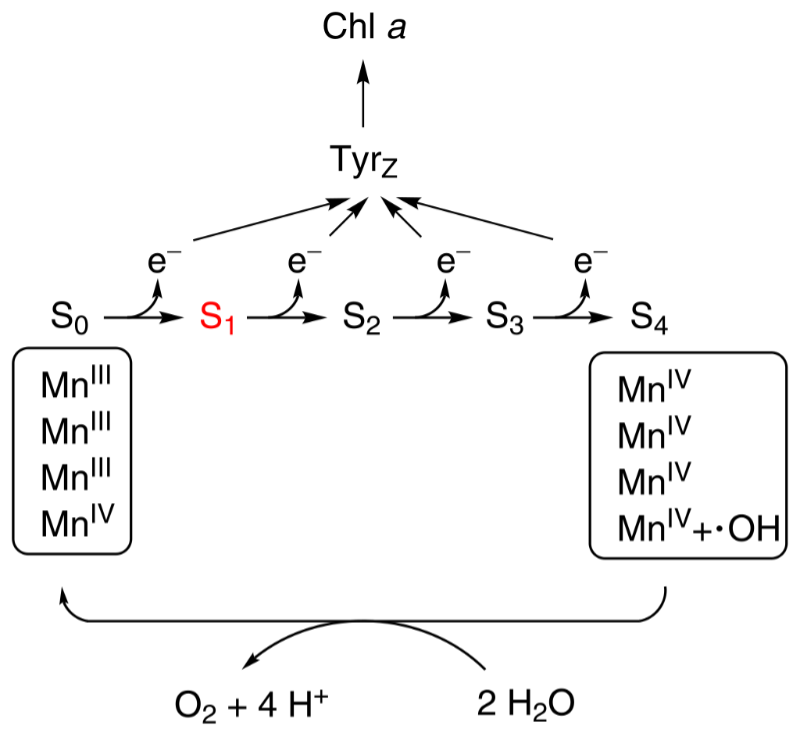
Attribution: Yikrazuul, Public domain, via Wikimedia Commons
Two properties of manganese make it an important element in this cycle. Not only can it form bonds with oxygen-containing molecules such as water, but it additionally has four different oxidation states, which enables it to move electrons to and from other substances more readily than other elements. Here manganese is a cofactor, or ‘helper’ in mediating reactions.
Four electrons are removed by manganese from two water molecules, which oxidises to two oxygen atoms (O) and four hydrogen ions (H+). The two oxygen atoms readily combine to form oxygen gas (O2), which leaves the cell and enters the atmosphere as a waste product. Oxygen is not involved in photosynthesis, it is merely the result of it.
Meanwhile, every time P680 is excited by a photon, it loses an electron to pheophytin. That electron is replaced with an electron from the tyrosine residue, and that electron is replaced by one from the manganese, which extracted it from a water molecule.
This electron flow moves from Photosystem II into the other protein complexes in the thylakoid membrane, to drive reactions there. The hydrogen ions (also called protons) stay in the lumen to drive energy production, also outside Photosystem II. These processes will be covered in separate chapters.
About the Author
BSc(Hons), U.Syd. - double major in biochemistry and microbiology, with honours in microbiology
PhD, U.Syd - soil microbiology
Stumbled into IT and publishing of all things.
Discovered jujube trees and realised that perhaps I should have been an agronomist...
So I combined all the above passions and interests into this website and its blog and manuals, on which I write about botany, soil chemistry, soil microbiology and biochemistry - and yes, jujubes too!
Please help me buy a plant if you found this article interesting or useful!